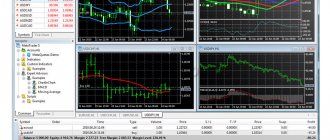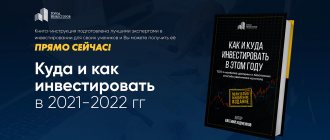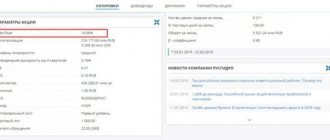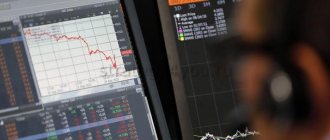Fundamental analysis (FA) is a method of measuring the intrinsic value of a security by examining interrelated economic and financial factors. Fundamental analysis examines everything that can affect the price of securities: macroeconomic factors (the state of the economy and the state of a specific business sector) microeconomic factors (the efficiency of company management).
The investor's ultimate goal is to find a value that he can compare to the current value of the security. This will allow the investor to see whether the security is undervalued or overvalued. Subsequently, he decides to buy/sell it.
This method is the opposite of technical analysis. Technical analysis predicts a price vector based on historical market data (price and volume). Investopedia recently published an interesting article on what fundamental analysis is and how to apply it. We have prepared an adapted version of this material for you.
What is fundamental analysis based on?
The main purpose of fundamental analysis is to determine whether a security is correctly priced in the market.
Fundamental analysis is carried out taking into account macro and micro factors. This way, securities that have been incorrectly (unfairly) priced on the market are identified. To understand the fair market value of a stock, analysts study the overall health of the economy and then a specific industry. Only after this do they move on to the performance of specific companies.
Fundamental analysis uses data to estimate the value of stocks or other securities. For example, an investor might conduct a fundamental analysis of a bond's value by considering economic factors such as interest rates and the overall health of the economy, and then examine information about the bond issuer (such as possible changes in its credit rating).
To study stocks, fundamental analysis takes into account:
- income;
- profit;
- potential growth;
- equity;
- profit rates.
and other data to determine the company's underlying value and its potential for future growth.
All this data can be found in the company's financial statements. Most often, fundamental analysis is used for stocks. But it is also useful for other financial instruments: from bonds to derivatives.
Why is it so popular among traders?
Techniques of technical analysis are universal; they can be used not only on the Russian stock market, but also to analyze Chinese stocks, or futures for orange juice concentrate, or anything else. The ease of use is captivating: even if a trader works with complex technical indicators, they are all built into the trading software and are absolutely easy to use.
In addition, today there is a huge amount of advertising, which is fueled by phenomenal success stories of traders using technical analysis.
Advantages and disadvantages
Indeed, one of the advantages of technical analysis is its universality of application for different markets - both Russian and any other. Another plus is that the principles of operation are the same for different timeframes, i.e. it doesn't matter whether you're looking at 5-minute charts or analyzing weekly stock market data.
Disadvantages include a high degree of subjectivity and the lack of real asset valuation factors. Investment champion and stock market guru Warren Buffett summed up the problems of technical analysis very well with the following phrase:
“I realized technical analysis wasn’t working when I flipped the chart over and it showed the same technical analysis.”
Investing and fundamental analysis
If the intrinsic value of a stock is higher than the current market price, the stock is considered undervalued.
It is recommended to buy it. If a stock's intrinsic value is lower than its market price, it is considered overvalued. It is recommended to sell it. Investors can be long (buying with the expectation that shares will rise in price in strong companies) or short (selling shares that will fall in price with the expectation of buying them back at a lower price from weak companies).
This method is contrasted with technical analysis, which predicts the direction of prices by analyzing historical market data (price and volume).
Force majeure
Traders and investors can predict some important events in the economic world - for example, the publication of financial statements, the consequences of a decline in the price of an asset, and so on. But some events cannot be predicted. This is called force majeure within the framework of fundamental market analysis. Sometimes you may hear another name: “black swans”. Force majeure includes, for example, man-made or natural disasters and military conflicts. All “black swans” can affect an asset in different ways: some can cause a market collapse, others can provoke its rise, others can collapse one industry and raise a second.
Here's an example: when Saudi Arabia's oil facilities were attacked by armed drones in 2022, oil prices rose 16-19% in just one day. This happened because investors were worried that oil supplies might stop? It is not difficult to guess that military actions usually provoke a rise in stock prices of companies in the military-industrial complex.
Let's give a reverse example. The accident at the Fukushima-1 nuclear power plant, which took place in 2011, dropped the Nikkei stock index by more than 20% in three days.
Political instability can also be a force majeure circumstance. Nowadays, many politicians actively use social networks, and any post or tweet can cause the prices of some stocks to rise and the prices of others to fall. Let's not forget about international relations - supply disruptions, the signing of a procurement agreement, sanctions and other factors are difficult to predict, but they can greatly affect price formation. You don’t have to look far for an example - in 2022, US sanctions against Russian companies led to shares of the aluminum production and supply company falling by 26%. In fact, Rusal was not the only one affected by the sanctions, but it was the one that lost the most points. Political instability and hostility between states also have a huge impact on the formation of exchange rates.
What should an ordinary trader do about force majeure? Here are some tips:
- Keep your finger on the pulse. Follow the world's biggest news. It is not necessary to spend half a day reading the news feed - the largest and most important news is enough, and there are usually no more than 5 of these per day.
- Analyze the impact of unpredictable news on the market. See how this or that news affected the value of companies directly or indirectly related to it. Soon you will be able to predict price movements yourself depending on the news.
- Learn to make decisions quickly. In the era of globalization, the market quickly reacts to certain news. As can be seen from the examples above, literally in one trading session the price of a stock can drop catastrophically.
Quantitative and qualitative fundamental analysis
Fundamental analysis data can cover everything related to the economic health of a company.
This may include revenue, profit, as well as the company's market share and management quality. Fundamental factors fall into two categories: quantitative and qualitative. The financial meaning of these terms does not differ much from their standard definitions.
- Quantitative fundamentals are hard numbers. These are measurable business indicators. The largest source of quantitative data is financial statements. In it you can accurately find out about income, profit, assets and much more.
- Qualitative fundamentals include the competence of company leaders, brand recognition, and patented technologies.
Analysts look at all these factors together.
Recommended brokers for trading
Fundamental analysis is just a market research method necessary for trading by opening an account with one of the brokerage companies.
The rating of Forex brokers from the Masterforex-V Academy is made up of 20 criteria and allows for 15 years of almost error-free monitoring of the activities of leading brokerage companies. The major league of brokers recommended by us includes 12 “ best forex brokers ”, in the reserve there are 20 companies of the 2nd league, the list of which is posted below.
| № | Broker name, year founded | Financial instruments and assets | Licenses from financial regulators | ||||
| Currencies | Goods | Stock market | Cryptocurrencies | PAMM | |||
| Major League | |||||||
| 1. | NordFX (2008) | + | + | + | + | + | CySEC, MiFID |
| 2. | Swissquote (1996) | + | + | + | + | — | FINMA, FCA, SFC, Dubai FSA |
| 3. | Dukascopy (1998) | + | + | + | — | — | FINMA, FCMC |
| 4. | Alpari (1998) | + | + | + | + | + | ARFIN |
| 5. | FxPro (2006) | + | + | + | — | — | FCA, CySEC, FSB, Dubai FSA, BaFin, ACPR, CNMV |
| 6. | Interactive Brokers (1977) | + | + | + | — | — | NFA, CFTC, FCA, IIROC |
| 7. | Oanda (1996) | + | + | + | — | — | NFA, CFTC, FCA, IIROC, MAS, ASIC |
| 8. | FXCM (1999) | + | + | + | + | — | FCA, BaFin, ACPR, AMF, Dubai FSA ,SFC, ISA, ASIC, FSB |
| 9. | Saxo Bank (1992) | + | + | + | — | — | Danish FSA, Consob, CNB, ASIC, MAS, FINMA, JFSA, SFC Hong Kong |
| 10. | FOREX.com (1999) | + | + | + | + | — | NFA, CFTC, FCA, ASIC, JSDA, MAS, SFC |
| 11. | FIBO Group (1998) | + | + | + | + | + | CySEC |
| 12. | FINAM FOREX (1994) | + | — | — | — | — | Bank of Russia |
| Second League | |||||||
| 13. | Forex Club (1997) | + | + | + | + | — | ARFIN |
| 14. | TeleTrade (Teletrade) (1994) | + | + | + | + | — | ARFIN |
| 15. | ActivTrades (2001) | + | + | + | + | — | FCA, SCB |
| 16 | FreshForex (Fresh Forex) (2004) | + | + | + | + | — | — |
| 17. | eToro (eToro) (2007) | + | + | + | + | — | ASIC, FCA, CySEC |
| 18. | FortFS (2010) | + | + | + | + | + | IFSC Belize |
| 19. | (2011) | + | + | + | + | — | ASIC, IFSC, CySEC |
| 20. | BCS Forex (2004) | + | + | + | + | — | — |
| 21. | GKFX (2009) | + | + | + | + | — | FCA, JFSA, DMCC, BaFin, AMF, AFM, Consob, CNMV, , CNB, NBS |
| 22. | NPBFX (Nefteprombank) (2016) | + | + | + | + | — | — |
| 23. | Admiral Markets (2001) | + | + | + | + | — | ASIC, FCA, EFSA, CySEC |
| 24. | Grand Capital (Grand Capital) (2006) | + | + | + | + | + | — |
| 25. | RoboForex (Roboforex) (2009) | + | + | + | + | + | CySEC, IFSC Belize |
| 26. | FinmaxFX (2018) | + | + | + | + | — | CROFR, VFSC Vanuatu |
| 27. | FXOpen (2005) | + | + | + | + | — | FCA |
| 28. | Forex Optimum Group Limited (2009) | + | + | + | — | — | — |
| 29. | EXNESS (Exness) (2008) | + | + | + | + | — | FSA Seychelles |
| 30. | HYCM (1989) | + | + | + | + | — | FCA, CySEC, CIMA, Dubai FSA |
| 31. | Alfa Forex (Alfa Bank) (2003) | + | — | — | — | — | Bank of Russia |
| 32. | Forex4you (Forex fo you) (2007) | + | + | + | + | — | FSC BVI |
Sincerely, wiki Masterforex-V - free (school) and professional Masterforex-V training courses for working on Forex, stock, futures, commodity and cryptocurrency exchanges.
Qualitative characteristics
When analyzing a company, four main indicators are always taken into account:
- Business model
: what exactly does the company do? Example: A company's business model is based on selling instant chicken. Does the company make money from this? Or does the bulk of your income still come from royalties and franchises? - Competitiveness
: A company's long-term success means the ability to maintain and maintain a competitive advantage. In this case, the company's shareholders can receive decent dividends for decades. - Management
is an important investment criterion. Even the best business model is doomed if company leaders fail to execute the plan properly. It is difficult for retail investors to truly evaluate managers in person. But you can always take a look at the corporate website and check the resumes of senior management and board members. How well did they perform on previous tasks? - Corporate governance is the policy of an organization; relationships and responsibilities between management, directors and stakeholders. Policy is defined in the company's charter and its internal regulations, as well as in corporate legislation and by-laws. Investors prefer to do business with a company that is managed ethically, fairly, transparently and efficiently. If this is not the case, the company’s management probably does not want this.
- Company industry: customer base, market share, industry-wide growth, competition, regulation and business cycles. Studying a company's industry will give an investor a deeper understanding of its financial health.
Indicators
Technically, a stock market indicator is a mathematical algorithm that includes various statistical data about the progress of exchange trading in the stock market and displays this in a clear visual representation. Indicators are divided according to the goals and objects of study. Now I will talk about the most common and important of them.
Oscillatory indicators
Technical oscillators are indicators of market volatility whose conditions may change over time. One of the most popular indicators in the stock market is an indicator of this type called Rate of Change (ROC). It helps determine the speed of trend dynamics. Its main advantage is that it is in some ways a little ahead of the market. In a practical sense, this means that the maximum indicator level of the instrument will be reached earlier than a possible reversal of the market trend, and the trader will have time to take the correct position before the trend in the stock market changes.
Areas of increased risk of trend changes in such a technical indicator are usually called overbought and oversold.
There are other types of oscillators, such as stochastics, but I will talk about them separately.
Intersections and divergences
I already touched on the concept of divergence and moving average crossovers a little earlier. In order to more competently and efficiently use such market iterations in their analysis, the trader is offered special technical indicators such as MACD (Moving Average Convergence-Divergence). Looking ahead, I will say that this indicator, by combining signals with divergence, gives very strong trading signals on the stock market.
Popular indicators
In the first place of popularity among technical indicators among stock market participants are moving averages of different types and periods. They are a must-have in the arsenal of almost every stock market trader. In second place are stochastic oscillators; they are used a little less frequently than moving averages, but they are still used regularly. The third place in the hearts of traders and the selected analysis tools of their terminals is occupied by RSI, or a technical indicator of relative strength.
Accumulation distribution, A/D
Here we are talking about the technical indicator of accumulation / distribution. It was developed by one of the successful figures in the financial industry, Mark Chaykin. This tool is largely based on volume analysis, its purpose is to find the imbalance between sellers and buyers. If we talk about its calculation in more detail, when calculating A/D, the minimum for the day is first subtracted from the closing price, then this indicator is divided by the difference from the daily extremes and multiplied by the daily trading volume. It is presented in the form of a regular curved line, which is located under the price chart. A/D is great at showing when market trends are supported by volume and when they are not. It should be taken into account that this technical indicator becomes uninformative for analysis when there is strong turbulence in prices in the stock market.
Average directional index, ADX
This technical tool came to us from 1978, its founder was Wells Wilder. ADX is designed to measure the strength of upward and downward trends in the stock market. In its usual form, it is located under the price chart. This is the intersection of several lines of different colors. When the +DI line is above –DI, strong buying sentiment prevails in the market. If it’s the other way around, then the bearish trend has taken over.
Aroon
This technical indicator belongs to oscillators. Visually it is illustrated in the form of two lines. It is also used to analyze the strength of a trend in the stock market. Its founder is Tushar Chand, an American inventor. Analysis of the stock market using this indicator is painfully simple: when the orange line, which characterizes the strength of the upward movement, rushes upward, it means that bullish sentiment prevails in the market. If the blue line takes the lead and tends to reach 100 units, then the market can be considered bearish.
MACD
The founder of this tool is considered to be Jarald Appel, who did a lot for technical analysis. The MACD calculation is based on two moving averages, with the help of which you can conduct an effective analysis of market directions and understand where possible turning points are located. This technical assistant can be represented as a system of lines or a histogram. If, when analyzing the market, there is a rapid rise in prices, but the MACD does not confirm this, then divergence is observed, and soon we can expect a change in the direction of the trend.
RSI
This tool for analyzing the relative strength of market sentiment in the stock market, like ADX, was developed by Welles Wilder. It shows the ratio of the average increase in the price of an asset to the average decrease in its quotes over a selected period of time. RSI has a high level of information capacity. Traders also choose it for analysis due to its ease of use and lack of complex settings. At the same time, it can outline overbought and oversold zones, as well as show the presence of divergence. Visually it looks like one curved line.
On balance volume, OBV
The first mention of this indicator was published by Joe Granville. This indicator is quite simple in its calculation algorithm: OBV sums up market trading volumes when rising and subtracts them when falling. Therefore, during its analysis, both negative and positive areas are used. It is believed that when OBV rises and the price of an asset stays the same, we can soon expect a serious increase in volatility in the stock market.
Stochastic
The famous trader George Lane was the first to use such a technical tool in his analysis. The purpose of the stochastic is to determine the strength of the direction of the price impulse and predict a reversal in quotes using a correction in the strength of the impulse. Stochastic looks like a curved line, but is reflected as a percentage value. The closer it is to 100%, the greater the likelihood of a change in the upward trend.
Quantitative Basis for Analysis
Financial statements are a document in which a company discloses information about its financial performance. Practitioners of fundamental analysis use quantitative information from financial statements to make investment decisions. The most important financial statements are: profit and loss statement, balance sheet, cash flow statement.
Balance sheet
A balance sheet is a statement of a company's assets, liabilities, and equity at a specific point in time. Balance Sheet refers to the fact that the financial structure of a business is balanced as follows:
Assets = Liabilities + Equity
Assets are the resources that a company owns or controls at a given time: cash, inventory, machinery, and buildings. On the other side of the equation is the total cost of financing to own these assets. Financing is carried out from liabilities or from equity. Liabilities are the company's debt, equity is the total value of all the assets the owners contributed to the business, including retained earnings (profits earned in previous years).
Cash flow statement
A cash flow statement is a statement of a business's cash flows over a specified period of time.
Typically, a cash flow statement is based on the following measures: Cash from investing (CFI): cash used to invest in assets, as well as proceeds from the sale of equipment or long-term assets.
Cash from Financing (CFF): Cash paid or received through the issuance and borrowing of funds.
Operating Cash Flow (OCF): Cash generated from daily business operations.
Types of charts
There are several generally accepted types of visual perception of exchange prices of stock instruments. Among them, the main ones are candlestick, line, and bar charts. Traders can easily access any of the presented types, but candlestick configurations are more often used. To complete the picture, I will talk about each of the ways to visualize prices on the stock market.
Candlestick chart
Japanese charts are a set of candles. Each of them shows the opening and closing price, as well as the minimum and maximum price for the reporting period. To indicate differences in the direction of price movement, the candles are painted in different colors. Most often, white for rising candles and black for falling ones.
Line graph
A line graph is familiar to most people. This is one line that sequentially connects the average points of movement of stock quotes on the stock market. This type of graph is considered the least informative, but it is more convenient for visually identifying general trends.
Bars
The technical essence of bar charts is identical in functionality to candlesticks, but is illustrated a little differently. Each bar reflects stock quotes for a certain period. It looks like a vertical line, on the left is a mural that tells you what the opening price was, and on the right is the closing price. The bar size is the price range for the time interval.
Market Review
In order to have time to make money on sharp movements in the exchange rate, you need to closely monitor all the news that affects it in one way or another and respond to them. As a rule, negative news leads to a fall in prices, and positive news leads to an increase. As soon as the news comes out, sudden movements occur in the market, because... traders shake up asset prices. They do this, often without knowing where the price will move next. After some time, the price begins to follow the trend caused by the news.
Institutional Investor Share Ratio (Inst Own)
The share of institutional investors reflects what percentage of shares are owned by funds, insurance companies, banks and other large private investors. The table below discusses the standard values recommended by P. Lynch ↓
| Coefficient value | Grade |
| Inst Own < 5% | Not an investment-attractive company |
| 5% < Inst Own <65% | The company can be considered for investment |
| Inst Own > 65% | Highly volatile stock |
conclusions
Fundamental analysis is a powerful tool that allows you to very accurately predict price movements over the long term. The main disadvantage of fundamental analysis is that it does not perform well in short-term trading. But it can bring big money if the investor makes the right analysis and acts in accordance with it.
I hope you learned a lot of new information from this article. Share it with your friends on social networks so that they can also become familiar with the basics of fundamental analysis.











